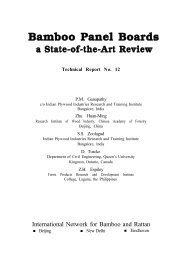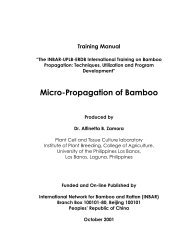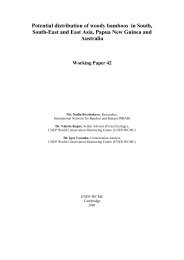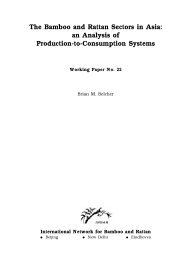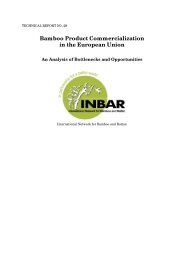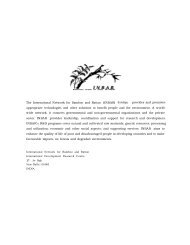ISSN ………… - International Network for Bamboo and Rattan
ISSN ………… - International Network for Bamboo and Rattan
ISSN ………… - International Network for Bamboo and Rattan
Create successful ePaper yourself
Turn your PDF publications into a flip-book with our unique Google optimized e-Paper software.
dioxide in later bleaching stages, it is possible to achieve high degrees of purification <strong>and</strong> brightness<br />
without the degradation of cellulose.<br />
The main disadvantage of the process is the extensive degradation of cellulose fibres as well as<br />
introducing high pollutants in the effluent. Further, higher brightness beyond 80 per cent is practically<br />
impossible while using hypochlorite. Alternatively, the use of chlorine dioxide can considerably<br />
reduce the use of free chlorine <strong>and</strong> the chlorination stage which has the advantages of lowering the<br />
consumption of oxidising chemicals as also sodium hydroxide at the extraction stages, improved pulp<br />
properties such as more stable brightness, improved effluent properties such as lower colour, toxicity,<br />
acidity, salinity, organic chlorides, COD <strong>and</strong> mutagenicity. The <strong>for</strong>emost advantage of using chlorine<br />
dioxide bleaching is the benefit of attaining brightness levels in excess of 85 per cent with the<br />
associated less degradation of cellulosic fibres. Practically all over the world chlorine dioxide<br />
bleaching has been in use <strong>for</strong> the last four decades.<br />
Multi-stage bleaching involves a series of stages, each complete within itself <strong>and</strong> operating under<br />
conditions previously described. The procedure may vary from two stages to as many as ten,<br />
involving chlorination, alkali extraction, hypochlorite, chlorine dioxide, <strong>and</strong> peroxide stages. The<br />
symbols used to describe the sequences <strong>and</strong> the various sequences, in practice <strong>for</strong> the bleaching of<br />
pulps are given in Appendix 6C, D &E. Pulps of different brightness may be obtained by varying the<br />
amount of chemical added, sequence of stages, <strong>and</strong> number of stages. The sequence of operation of<br />
the various stages will depend on the type of unbleached pulp, the quality of the bleached pulp, the<br />
brightness desired, <strong>and</strong> the economics of the process.<br />
In most commercial processes chlorination is still the first bleaching step, <strong>and</strong> is also called the prebleaching<br />
stage. Chlorine converts the residual lignin in water- <strong>and</strong> alkali-soluble degradation<br />
products, <strong>and</strong> is there<strong>for</strong>e generally followed by an alkaline extraction step to remove those<br />
components.<br />
4.3.1.2. Substitution <strong>for</strong> chlorine<br />
As chlorination causes the largest number of environmental problems with the bleach plant effluents,<br />
many attempts have been made to replace chlorine or to reduce the amounts of chlorine used or the<br />
chlorinated products in the effluents. This can be accomplished by cooking the pulps down to low<br />
kappa numbers, thus reducing the chlorinated organic load in the effluents, or by replacing part of<br />
chlorinated lignin fragments. Replacing chlorine altogether by peroxide or oxygen bleaching enables<br />
processing of effluents with few problems with regard to environmental protection.<br />
23



